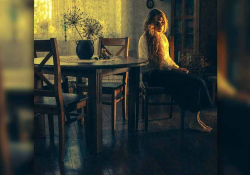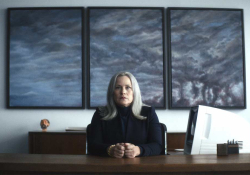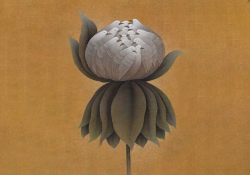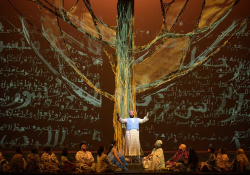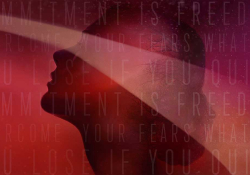The Tragedy of Timișoara
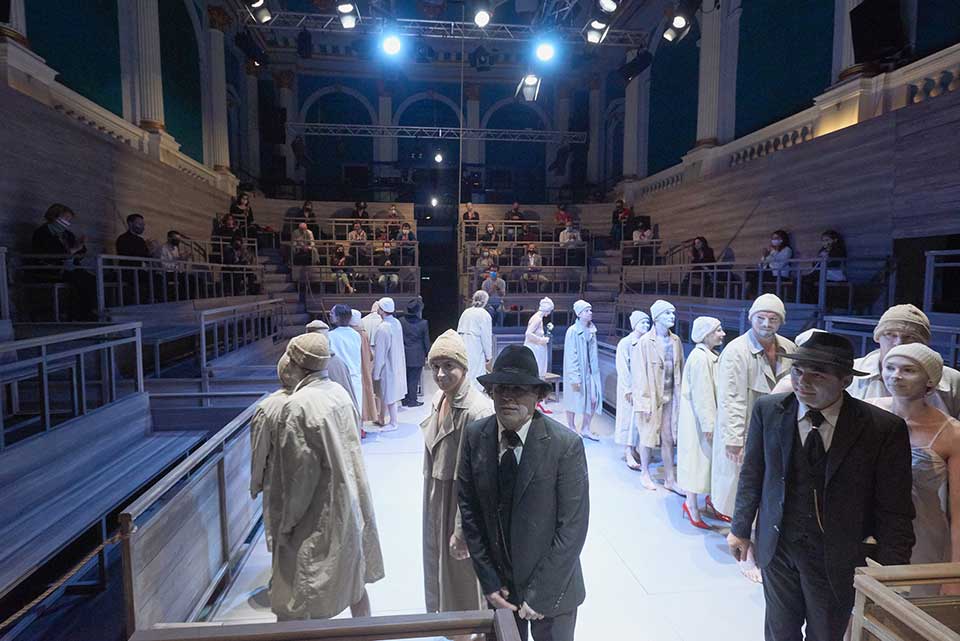
The Tragedy of Man, by Imre Madách, premiered at the Gergely Csíky Theater of Timişoara on March 3, 2020, directed by Silviu Purcărete and adapted by András Visky. After two performances, the run had to be suspended, due to the pandemic, and was only revived briefly in October. Melinda Mátyus reflects on her witnessing these two very distinct performances, highlights the irreversible changes that have taken place in theater-making and spectatorship, addresses this event as an apocalyptic warning, and offers a much overdue women-centric reading of the play known as the Hungarian Faust.
Two Performances
I’ll talk about the Tragedy of Timișoara focusing on the differences between the two versions presented in March and October. These two performances are different in more ways than the ones that make all performances unique and unrepeatable.
On the 3rd of March:
We went to the theater, and arrived at a theater.
We chatted in the foyer, given that in Timișoara, the (Hungarian) theater is (also) the meeting place of a close-knit community.
During the performance, we were there, in it, in the emotions and sensations that those two hours opened up before and for us.
After that, we drank some wine and chatted again.
And yes, we were under the influence of the events of the play, so we kept silent a lot, even in each other’s company.
Then we went home, and our home was exactly as it had been the year before.
On the 10th of October:
Going to the theater was preceded by complex personal considerations, such as how safe it was to go among people, what our medical condition was, whether we endangered others, and whether a two-hour-long performance could actually be enjoyed wearing a mask.
Those of us who did go stayed far away from one another, we didn’t talk, and yes, we could only focus of the performance.
And yet, we weren’t actually concentrating only on the performance, words like apocalypse, war, pandemic had moved into us.
Because this is what the stage has offered: apocalypse, war, and pandemic. Our senses have tuned in to this, seeing that apocalypse, war, and pandemic are now over all of us.
And we have no idea how to live in such times.
Most of the text, movements, and scenes have changed between March and October, because our perception of the world has also changed.
“The creator takes his rest,” we hear, sure, we mutter behind our masks, “Or you dislike what I have created?” asks The Lord, and we understand Lucifer, well, not really, we think, “Adam, Adam! You have abandon’d me, I also leave you. See what you are, alone.”[i] We hear the Lord’s Voice, why have you forsaken us, why exactly, we ask.
The performance space has a different echo.
In the Athens scene, we are waiting with Miltiades’ woman, after all we have also been waiting for the last eight months.
We are more permissive with Catullus and his court than back in March, we are confused nowadays, life is so short!
But Paul the apostle’s martyrdom is also in the air, for the first time since the Reformation, and the strong scene of the phalanstery ruffles our feathers, our soul almost freezes.
As the actors take their curtain call, I can see that they also feel that it has been a very different performance today, the auditorium and the stage have interconnected.
We know more of each other.
Yet actors and spectators have been moving away from one another, this time the actors couldn’t rely on the spectators’ faces.
The spectators, on the other hand, have gained an insight into the practical challenges of theatrical performances—wearing a mask is difficult, for example.
We went home from this theater, a theater that has become a dangerous place because of its potential for social contact.
We closed the door behind us, sanitized our hands, and dropped our masks into the bin.
Home has become the only space where we can be mask-free.
The place of safety, or the illusion of safety.
In the production, we are witnessing a series of spine-chilling scenes where the successive Adams and Eves appear interchangeable, insofar that the couples keep swapping roles and masks are used to indicate to whom we should pay attention.
Through the many Adams and Eves, we all become part of the human story-chain.
These are human stories that run through history—they evolve from the story of creation, they are built from it. And it is at this point, in the alternating cast, that the theater director’s biblical conception is most evident: through the many Adams and Eves, we all become part of the human story-chain.
Additionally spine-chilling are the white masks worn by the actors currently performing Adams and Eves.
And what (also) follows from this: the separation of sound and body.
The fissure and division.
One Adam and one Eve speak into microphones, while another Adam and another Eve act.
They either let out a sound or act.
At the beginning, I only pay attention to the actors in motion, a scene might even come to an end by the time I realize that the speakers are also standing right before me.
The movement of the actors is slow and sketchy, their movements connect invisible, important points, and this movement sometimes creates liturgical spaces and actions. The game is like a slow dance, waiting to be imitated, everything that happens in front of us on the stage happens in us as well.
Could we really be this fragmented within ourselves, that we are only able to either move or speak?
Who is speaking, I’m shivering in the auditorium, who is speaking and who is moving, and who is first, because it’s impossible to be entirely simultaneous. Could we really be this fragmented within ourselves, that we are only able to either move or speak?
Always inadequate for simultaneous movement and speech? Inadequate for being whole, too?
Eves in blood-red stilettos
The two creators, Silviu Purcărete and András Visky, are sensitive to the Eve of the Tragedy. Madách speaks to us as our contemporary—in András Visky’s language.
Visky’s work is a complex version: this is what appears on the poster, a reading by András Visky and Silviu Purcărete.
I feel humility in Visky’s dramaturgy; his goal is to create a performance that the spectator can love and accept by reflecting further on the original work.
To this day, the portrayal of woman in the Tragedy brings sensitivities and wounds to the fore that everyone (every woman!) feels, these cannot be ignored by appealing to textual integrity alone.
In the initial image, the Lord is “might, and bliss and knowledge,” and later the three archangels glorify the idea. Adam gains power from this, and increasingly more and more knowledge.
Eve, on the other hand, is a senseless, emotional being, she mostly moves on the surface, and at best, she can be Adam’s arm candy.
Madách condemns her to a background role.
Her essence is conformity, she is tied to matter, age, and her personality changes from scene to scene.
While Adam and Lucifer fight as equals, Eve is always the third person, she has no access to language for lofty debates.
Although her pregnancy saves Adam from suicide, she also receives a few kind words from the Lord in the last chapter, however motherhood also remains exclusively in the realm of body and matter.
In the scene of awakening, Eve seems to “get pregnant” by accident, motherhood is not her personal decision.
Having said that, our relationship to the text will continue to be one-sided, if we only pay attention to these points; after all, Eve also has the potential to turn these scenes upside down, as my reading below demonstrates.

“Ah life, ah life, how sweet, how beautiful”
In the opening scene, Adam and Eve walk on a table, in Eden itself, surrounded by fruit.
And above the table, there hang two red apples.
The boundary set up by the Lord spectacularly disappears: the fruit that draws these boundaries are picked and eaten one by one.
Eve begins to learn life, and in this learning, she finds speech, tastes language and life together, turns them toward each other. This is one of the delicacies of the performance.
It is Adam who discovers the two hanging apples, and he is also the one who approves of the transgression: “God’s curse lies on it. / Yet reach forth thine hand.”
But the apples are high above, Eve can’t reach them.
A beautiful theatrical moment follows.
Lucifer places a pair of red stilettos at Eve’s feet, who is still chattering like a silly girl, Eve then puts the red stilettos on—and plucks the apple.
She immediately becomes a woman and the table turns into a catwalk.
The red stilettos take Eve to the knowledge of good and bad—since it was exactly this 5.1-inch gap that was missing!—but also to her identity as a woman. And these two almost coincide. On stage, the eroticism of the woman is born, and with this, the struggle of man for woman and power can begin.
The red stilettos take Eve to the knowledge of good and bad.
Eve is no more ridiculous or stupid than Adam, nor do we notice that Eve would be much “smaller” and more fragile.
Purcărete places the scene on the table and thus changes our (spectatorial) perspective.

“Perchance thou wouldst a kiss?”
A hysterically laughing Roman Eve arrives, her voice preceding and even anticipating her.
In the crumbling Rome, Eve is as diverse as the empire itself, a moving, tiny, uncertain point—in the age of the plague.
We can hardly follow her changes in condition and shape: her empty life in the Roman bath is a gaping hole.
She can’t even wear her red shoes, she puts them on her hands and wiggles with them; crossing the boundary of pleasures at this magnitude eliminates pleasure itself. Love and erotica devour themselves.
Then two strong scenes spin on each other.
Eve lies on the corpse of a plague victim, her performance causes confusion even in her own circles, and right after that we see the dying, naked Eve, lonely and startled, wallowing on the ground, in her red shoes. This is a heartbreaking sight.
Then a group of Lucifers appear as disinfecting firefighters, and Eve is kept on stage at a safe distance from the healthy.
Peter, the apostle, is the only one who isn’t afraid to touch the sick body, baptizing Eve in the last moments of her life. It is not clear to me how aware Eve is of everything, the scene is perhaps too fast to create such a (inner) story.
The plague is present everywhere and behind everything, in the bitter scenes that blur into one another, in the broken, fast movements, plague and fear lurk everywhere.
Hysterical self-destruction.
I’m embarrassed and I think that everyone else is, too. We recognize that our situation is similar to that of the Roman scene, we are trapped.
Then it was the plague, now the coronavirus.
Then it was fear that is present today, too.
Eve meets her end wearing her red shoes.

“Doth not thy conscience weigh upon thy soul?”
The strongest and most impressive images of Eve are in Paris. At the beginning of the scene, Eve is an aristocratic woman, a little later a revolutionary-prostitute. The transformation is spine-chilling, the same woman arrives at the table, there’s the same dress, set, and sound. Eve is a lady of impeccable appearance at first, later she becomes worn and torn. But it is not the external change that shocks the spectator, it is the soul of the prostitute Eve that darkens, she becomes a professional revolutionary and someone who’s a murderer for a living.
It only takes five minutes for this transformation to take place, and we freeze and ask ourselves whether it would be really possible for a woman to fall so much so soon.
The presence of orator Danton-Adam is strong, his table scene is both grotesque and spine-chilling. Human heads fall like cabbage heads with wigs, each head of cabbage lands on the lap of a French citizen.
Plenty of valuable trophies.
Yet the greatest moment of the Parisian scene belongs to Eve.
She appears in a monumental outfit that fills the entire table, her gestures are wide, her movements slow. First, we see her wearing an impeccable wig, then she’s ruined, wearing the red shoe only on her right foot, her clothes are dirty, her wig tousled, and she speaks obscenities.
In Timișoara, the center of the French scene is Eve, the creators keep her on the table for an extended period of time, in the hottest spot of the revolution.
Marquise-Eve is the only winner of her age and of the Parisian scene, even in her death.
The greatest scene is that of the prostitute Eve. Drunk, with uncertain movements and a red stiletto on her right foot—she plows through the table and pees in reverse tricolor: red, white, blue.
The scene is frivolous, fallible, intimate, and painful at the same time. A compressed image of the (French) revolution.
This is a very spectacular yet not excessive scene, using the strongest of gestures.
It deeply sinks in.
A lot has happened since October, and by this I mean basically nothing.
The production was meant to tour the Interferences International Festival at the Hungarian Theater of Cluj in November, but in the meantime this festival had also moved to a selection of smaller and larger screens.
In lieu of experiencing life itself, we are fiddling around with imagining life, making use of wide gestures instead of speech. Because it is essential that we are understood from behind our masks, even from afar.
I slam the car door on my finger and am taken by surprise when I find that the pain I feel is real.
This week, I had to leave the house twice on various errands.
I make sure to walk at a safe distance from others on the street, even though, like everyone else, I’m in a rush. Week after week, I see more clearly: a succession of Adams and Eves keep appearing from nowhere, before they disappear into thin air. We are all the same.
Purcărete’s Tragedy has moved out of the theater and relocated right here in our midst. But which came first, I muse.
Translation from the Hungarian
Editorial note: This is an excerpt from a longer essay dedicated to the production, to be published in the trilingual volume Az ember tragédiája / Tragedia omului / The Tragedy of Man (Koinónia, 2021).
[i] Drama quotations taken from Imre Madách, The Tragedy of Man, trans. J. C. W. Horne (Corvina, 1963).



